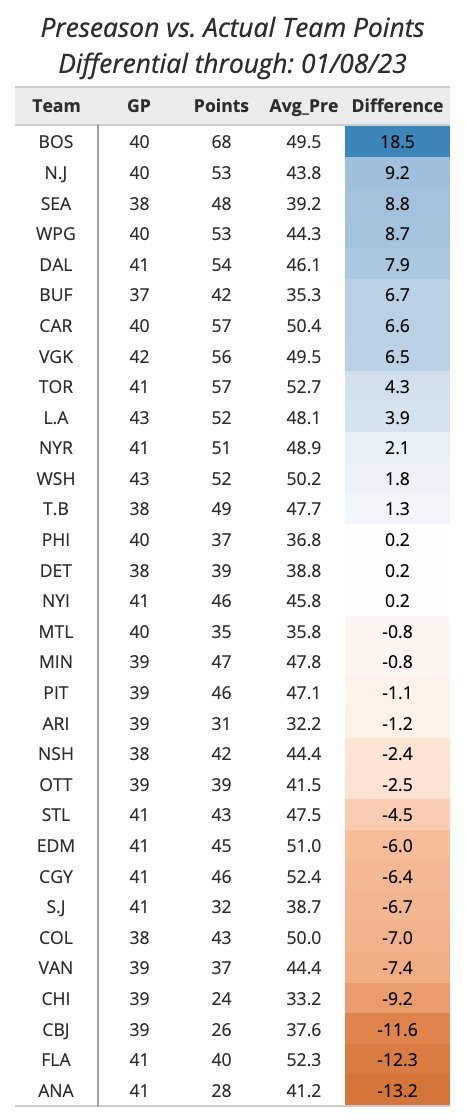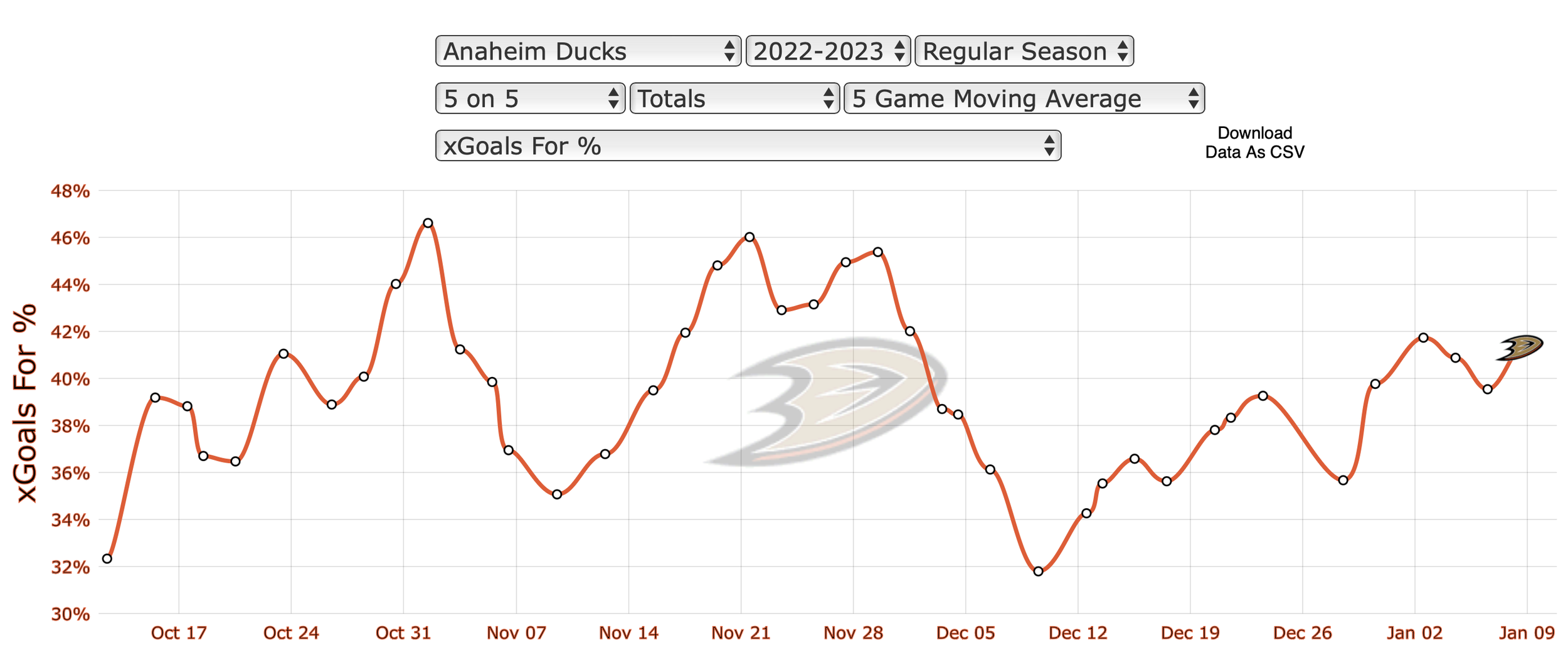As bad as it gets: Anaheim Ducks 2022-2023 midseason review
The Anaheim Ducks have officially reached the midway point of their 2022-2023 season after their 7-1 loss to the Boston Bruins at Honda Center this past Sunday. Following a busy summer that saw GM Pat Verbeek sign several enticing free agents, anticipation and excitement was high amongst Anaheim’s fanbase for their 2022-2023 campaign. However, the Ducks have struggled mightily through the first half of this season, underperforming even the lowest of expectations some had for the team during the preseason. Crash The Pond will take an in-depth look at what has gone wrong for Anaheim, and preview what may lie ahead as we move into the second half of the 2022-2023 season. Unless otherwise noted, all statistics cited in this article are obtained from Evolving Hockey.
tEAM box-score statistics and record relative to preseason projections
Through 41 games, the Anaheim Ducks have posted a dismal 12-25-4 record (28 points, 8th in Pacific Division, 15th in Western Conference). Anaheim currently ranks 31st in the NHL in Goals For / Game (2.3), and 32nd in Goals Against / Game (4.1). Their power play ranks 31st in PP% (15.3) and their penalty kill ranks 30th (71.4). The Ducks have also tallied the 4th-most penalty minutes in the NHL through the first half of the season (482).
As shown below courtesy of Evolving Wild, the Ducks have been the most underperforming team in the NHL relative to preseason projection models throughout the hockey analytics community, earning ~13 points fewer, on average, than their projected total through 41 games.
TEAM ON-ICE PERFORMANCE
The Ducks have also struggled mightily from an on-ice perspective this season. They have posted a 38.4% xGF% and a 42.1% CF% at 5v5 through 41 games, ranking 32nd and 31st in the NHL, respectively. On the powerplay, Anaheim’s xGF/60 is 7.8, which is ranked 22nd in the NHL, and on the penalty kill, their xGA/60 is 10.2, which is ranked 30th. Their game-by-game 5v5 xGF% is shown below, courtesy of MoneyPuck. Stunningly, the Ducks have only posted a 5v5 xGF% above 50% in 4 out of 41 games this season.
An effective visualization of the 5v5 expected goal rates throughout the league is shown below, courtesy of HockeyViz. The Ducks sit firmly entrenched in the bottom-left quadrant of the graph, reinforcing the notion of their poor on-ice play at 5v5 through the first half of the season.
Even Anaheim’s most prominent detractors probably could not have predicted this level of futility from the team after an offseason of development from the Ducks’ young core, and the addition of veteran free agents John Klingberg, Ryan Strome, and Frank Vatrano. To better understand the details of Anaheim’s historically poor start to the season, let’s take a closer look at each position group on this Ducks team.
FORWARDS
The 5v5 on-ice metrics for Anaheim’s forward combinations this season (minimum TOI: 50 minutes) are shown below. Their top line of Adam Henrique - Trevor Zegras - Troy Terry has been exceptional, generating the majority of quality chances and shot quantity during their time on the ice. Inexplicably, Ducks head coach Dallas Eakins recently decided to break up this line, which makes little sense given their consistency, and the fact that they are the only Ducks forward line to post xGF% or CF% numbers above 50% for the season so far. The rest of Anaheim’s forward combinations have been outperformed by opposing teams from both a chance quality and shot quantity perspective. The two lines that have been centered by Ryan Strome (McTavish - Strome - Vatrano and Vatrano - Strome - Silfverberg) are ranked in the bottom 5% of all NHL forward lines in terms of xGF% with a minimum TOI of 50 minutes (253rd of 261 and 256th of 261, respectively) this season.
Despite the widespread poor play from Anaheim’s forwards, and especially new free agent additions Ryan Strome and Frank Vatrano, several notable bright spots have shined across the otherwise bleak landscape in Anaheim during the first half of the season. Troy Terry, Anaheim’s top-line right winger, earned his 2nd consecutive All-Star appearance, which he was recently informed of in epic fashion by Hall of Fame NFL quarterback and namesake, Troy Aikman. Terry has tallied a team-leading 33 points thus far (12G, 21A). His EV and PP RAPM charts are shown below, courtesy of Evolving Hockey. Building off of a breakout 2021-2022 campaign, Terry has continued to excel in generating quality offensive chances and has been a force to be reckoned with on the Ducks’ top powerplay unit.
The Ducks have to be thrilled as well with the performance of young center Mason McTavish, who is playing in his first full season with Anaheim. McTavish currently ranks 2nd in points for all NHL rookies with 26 (9G, 17A), just 6 shy of Kraken center Matty Beniers (15G, 17A).
Anaheim’s forward play through the first half of the 2022-2023 season has been well below average, with several notable exceptions. However, the unquestionable anchor that has been primarily responsible for sinking the Ducks this season has been their historically bad defensive play.
DEFENSEMEN
Anaheim’s team defense has been on the ice for the most goals against (167) in the NHL this season. From a 5v5 on-ice perspective, the 2022-2023 Ducks have been historically bad. Their 5v5 xGA/60 ranks last in the NHL (3.5), and this is the worst xGA/60 rate of any team in the NHL over the last 15 seasons.
The Ducks’ best defensive combination this season has been the previously deployed 3rd pairing of journeyman LHD Nathan Beaulieu and veteran RHD Kevin Shattenkirk, who lead all defensive pairings with a very poor xGF% of 42.5% (minimum TOI: 100 minutes). The free agency signing of RHD John Klingberg has been a failure from an on-ice perspective through the first half of this season. Klingberg has played most frequently with LHDs Cam Fowler and Simon Benoit, and the returns on both lines have been extremely low (41.1% and 33.9% xGF%, respectively).
Klingberg’s defensive play has been especially poor from an on-ice perspective. His EV and PP RAPM charts are shown below, courtesy of Evolving Hockey. While he has been slightly above replacement at generating quality chances offensively, Klingberg’s xGA/60, which quantifies his ability to deny quality chances defensively, has been off-the-charts bad at over 4 standard deviations below league average. Klingberg has brought value to the Ducks powerplay unit, helping to generate quality chances and ample shot volume.
While some of Anaheim’s forward lines have played poorly, the key driver behind the Ducks’ abysmal record through the first half of the 2022-2023 season has been their historically bad defensive play. There is no question that the Ducks suffered to some extent as a result of the early-season shoulder injury suffered by RHD Jamie Drysdale. However, the very poor play from John Klingberg, along with veteran LHD Cam Fowler and recently acquired LHD Dimitry Kulikov, have contributed greatly to the all-time poor performance we have witnessed on the Anaheim blue line this season.
GOALTENDERS
Anaheim’s goaltending has not been headline news one way or another this season. Starter John Gibson has not played particularly well, posting a -3.0 GSAx, but he has not been helped in any way by the defensive pairings playing in front of him. Backup Anthony Stolarz has been his usual steady self, posting a slightly above-average GSAx. Perhaps the most compelling story of the 2022-2023 season from a Ducks goaltending perspective was the outstanding play of Lukas Dostal when he was called up to the NHL in December after injuries to both Stolarz and Gibson. Dostal was extremely impressive in 7 games played, posting a stellar 4.8 GSAx over that short stint as the starting goaltender, along with a 91.3% save percentage.
As we approach the trade deadline on March 3, rumors will no doubt swirl again over whether or not the Ducks would ever move Gibson for a blockbuster return package. Stolarz will become a UFA after this season, thus making it very likely that Anaheim GM Pat Verbeek will look to deal him for assets before the deadline. This would also potentially pave the way for Dostal to become a fixture on the Ducks roster for the end of this season and heading into next season.
Coaching
Last but not least, a discussion surrounding the Ducks’ atrocious start to the 2022-2023 season would not be complete without an evaluation of their coaching staff, and in particular, head coach Dallas Eakins. While Eakins deserves some level of praise for the continued positive development of Zegras and McTavish, it cannot be argued that his issues with respect to line construction and player evaluation have not improved under the new regime of GM Pat Verbeek. Examples of these issues have included the pairing of McTavish with low-event wingers such as Max Jones and Brett Leason, as well as giving a high volume of minutes to LHD Simon Benoit, who has been among Anaheim’s worst defensemen from an on-ice perspective this season. Eakins also has a penchant for shuffling forward line combinations with little discernible underlying logic. A recent example of this was Eakins’ demotion of Trevor Zegras, one of the Ducks’ most valuable forwards, from 1st line Center to 2nd Line LW. In addition, the historically poor defensive performance that Anaheim has exhibited this season must partially be attributed to poor structure and a deficient system, rather than just placing blame on individual players. Overall, through the first half of the 2022-2023 season, Dallas Eakins has not improved his chances of being brought back on a new contract as Anaheim’s head coach of the future.
Looking forward: the future is still bright
As Anaheim spirals towards their 5th consecutive season outside of the NHL playoffs (extending the franchise record they set after missing the playoffs last season), diehard Ducks fans have every right to feel demoralized, despondent, and disinterested due to the historically poor performance of their team thus far through 41 games. However, there are still many reasons for optimism heading into the 2nd half of the 2022-2023 season. Verbeek has plenty of pending UFAs to potentially deal ahead of this year’s trade deadline (e.g., Klingberg, Shattenkirk, and Stolarz) in exchange for prospects and/or future draft picks that will continue to buoy the Ducks as they progress forward towards the end of their rebuild. Ducks fans will also have the pleasure of continuing to witness the development of their young core. In particular, rooting for Mason McTavish to capture the Calder Cup will be enthralling. Finally, even if the Ducks ultimately end up picking in the top 5 of the 2023 NHL Draft, that has the potential to be quite a consolation prize for another lost season given the elite talent projected to be available in this year’s draft lottery. Despite the dark clouds overhead, Ducks fans still have every reason to be proudly wearing shades as they step into the future.









